Telcos in the Asia–Pacific region are actively planning an IP convergence roadmap
for their voice networks. Soaring stock valuations, aggressive debt financing and
over-investment during the ‘telecoms bubble’ have forced these operators to focus
more than ever on business fundamentals. Competition has driven down tariffs, often
to non-viable levels, while at the same time the operators’ networks are ageing.
Many incumbent operators have additional problems, having recently been subjected
to competition and – for those being privatised – increasing scrutiny from investors.
The Business Development (BD) team at Siemens, based in Singapore, has been working
with telcos in the region to analyse the economic value of their planned investments:
- to determine if postponing an NGN investment is a short-term fix which may lead
to a long-term loss of economic opportunity
- to evaluate the revenue potential of a new application
- to identify and quantify a reduction in operational costs.
Working with the client’s finance and marketing groups, the team uses STEM to determine
the break-even of investment in Siemens SURPASS NGN Solutions and how this will
improve the operator's Return of Asset (ROA).
The NGN business cases analysed suggest a number of key common positive drivers
which can lead to a rapid break-even of the investment, especially if they are all
relevant to a particular case:
- particularly strong revenue from a portfolio of applications and services
- reduction in number of sites to free up additional capital
- consolidation of data and voice networks.
A telco may use this analysis to assess how NGN migration would improve key financial
indicators and, in turn, its market valuation. This aspect is especially interesting
for operators which are about to be privatised.
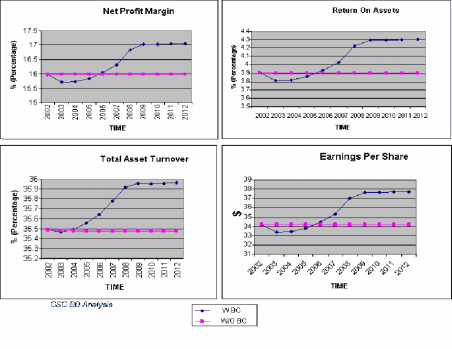
Effect of NGN migration on key financial indicators (Source: Siemens)
Working closely with telco teams to model an NGN business case
The analysis of each NGN business case is typically a joint effort with the operator
(with confidentiality of client information ensured by a non-disclosure agreement).
While Siemens consultants investigate the business-case drivers and construct the
financial model, the client team members advise on the network plan and provide
relevant input parameters. This arrangement enables the team to call on specific
expertise from each side, and ensures that accurate inputs are used and that key
assumptions are agreed by both sides.
STEM is used by Siemens’ Business Development team worldwide for its most demanding
and complex business case analysis. In most cases, various Excel modules are linked
as the interface for each of the input categories – market, traffic, operation cost,
etc. These spreadsheets are shared with client team members to allow them to gain
complete understanding of the underlying business case calculation. For clients
who do not have a STEM capability, the architecture of the business case’s STEM
model is thoroughly and openly explained.
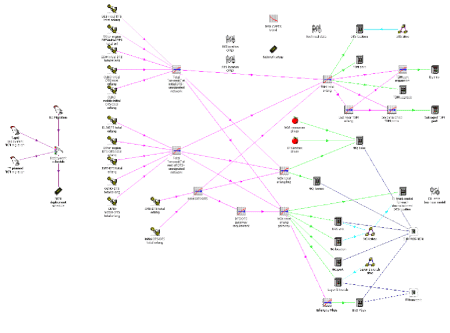
STEM model of an NGN migration (Source: Siemens)
The picture above shows an example STEM model of a Class-4 (transit plane) NGN migration
for an incumbent in South-East Asia. Besides the NGN network dimensioning and costing,
and the associated cost reduction from current TDM network operation, the model
also includes the economic value of trunks that are freed up due to the decommissioning
of some sites, as well as selected next-generation applications.
A reduction in operating costs, especially those related to network staff, is often
a key driver of an NGN business case. However, this is difficult to quantify as
headcount is usually sensitive information which most operators are hesitant to
reveal. Instead of simply determining the headcount, therefore, an activity-based
analysis is used. This method identifies all key activities that network staff perform
and the effort required for these activities (obtained from staff activity logs
and interviews), in order to assess how NGN migration will affect each of these
activities. Some are cut substantially by centralising processes at the softswitch,
some are reduced by installing more reliable and higher-density network components,
while some are unchanged or even increase, such as the provision of voice QoS.
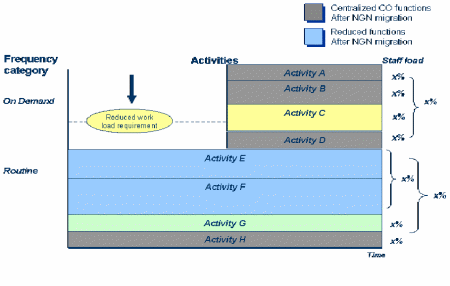
Activity-based analysis of impact of NGN migration on staff loadings (Source: Siemens)
From case to case, savings of up to 60% in operating costs relating to network staff
have been observed from NGN migration using this method.
Gaining strategic insight from varying assignments
Beyond number-crunching and generating the basic business-case figures (such as
Net Present Value and break-even period), joint projects reveal many strategic insights.
For example, in an assignment for a North Asian CLEC, the team assessed the substantial
economic value of being able to provide a true (quality-differentiated) budget VoIP
service, which enables the client to keep its price-sensitive customers while maintaining
the current price level of its voice service.
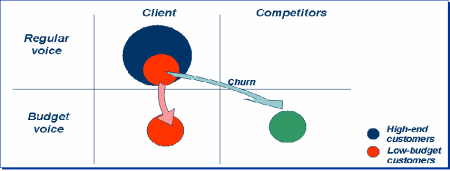
Providing a budget VoIP service helps retain price-sensitive customers (Source:
Siemens)
For a South-East Asian incumbent, currently running an ageing TDM network, and which
still expects traffic growth, NGN migration was shown to offer capex savings in
the long run. This is because without NGN, the operator will need to invest in new
TDM ports to support traffic growth as well as to replace old TDM equipment reaching
the end of its service life.
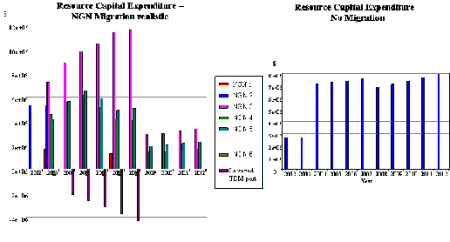
Effect of NGN migration on network capex (Source: Siemens)
The strategic insights gained by the BD team from each business case project represent
valuable experience and lessons learned which can be applied to the next client
project.
Siemens Information and Communication
Networks (ICN) provided solutions for IP-based voice/data convergence, broadband
access and optical transport networks to enterprises, carriers and service providers
in 160 countries.